









Image Credit : Richard Glover

Project Overview
This was a scene of social degradation. Many of the locals wanted the homeless inhabitants kicked out of the area! The homeless considered it their turf and wanted to remain in their hang-out, but they also wanted it improved. Into this context Terragram and CEA have delivered two sparkling new parks that score highly in both physical and social sustainability.
Project Commissioner
Project Creator
Terragram with Chris Elliott Architects
Team
Landscape Architects and Head Consultant: Terragram
Architects: Chris Elliott Architects
CONSULTANTS
Structural Engineers: Rooney and Bye
Heritage: Geoffrey Britton
Electrical Consultant: Webb Australia Group
Access Consultant: Accessibility Solutions
Arborist: Sydney Tree Consultancy
BCA Consultant: Tom Miskovich & Associates
ESD Consultant: Cundall
Planner: David Crane and Associates
Photographs: Richard Glover
Project Brief
This project was a political "hot potato"
For the local residents the parks were a "no-go zone"!
Throughout the parks people were sleeping or passed out. Clothing, blankets, mattresses and other belongings and rubbish were strewn about the place, even on the toilet roof. The dilapidated facilities in Walla Mulla Park were lined with pornographic graffiti, excrement and vomit. A side room contained was filled with syringes. Bourke Street Park had no facilities, just a temporary builder's toilet.
People were screaming for action. Council was forced to walk a fine line trying to please both sides. They conducted an extensive community consultation process but it was clear that it would be difficult to please everyone.
Everyone wanted something done!
But what to do??
Project Need
Walla Mulla Park was dirty, gloomy and unattractive. The idea here was to eliminate the existing retaining walls, and many of the trees. The park needed to be emptied out to enable a better and easier flow through the park, and facilitate easier cleaning by council trucks. Given that there was not much space for gardens vertical gardens were adopted instead.
We chose to incorporate the amenities structure into one of the large steel trellises that line the two “urban walls”. The structures are connected seamlessly. The intention is that the vines will eventually grow up and extend along the mesh roof to hang over the edge forming a “green cascade”.
The siting of the Bourke Street amenities was constrained by the viaduct (it couldn't be under it), the community garden and some existing trees that were to be preserved. Its layout was generated by the need to provide an entrance to the garden, an accessible toilet and an storage room and potting bench and trough for the gardeners. The roof is a 6mm thick steel folded plane supported by just two circular steel posts. It sweeps up to allow in air, light and some rain!
Design Challenge
An important part of the brief was that there should good surveillance, people need to be aware if someone is in the toilet, especially at night. We used panels composed of stainless steel with cutouts combined with a translucent material to satisfy this requirement. The stainless steel doors are laser cut to a pattern that was abstracted from the plan of the park.
New grassed areas were provided and in the case of Bourke St, some exercise equipment and a community garden, where locals could grow vegetables and socialize. No longer do the parks carry such a foreboding stigma, but rather they have a sense of dignity and comfort, enhancing the mixing of people of various socio-economic and cultural groups.
This was a difficult project with a clear social agenda. This area has always attracted Sydney's outcasts, those on the margins or beyond the boundaries of polite society. We are very pleased that we've helped to give them a little more safety – and dignity.
Sustainability
This is a tough urban area and it was important that the materials used were similarly tough, durable and graffiti resistant. The chosen palette consisted of concrete flooring, concrete blockwork with ceramic tiles and steel roof structures. The long term future of the parks is uncertain - changes in council's urban design plans may mean that in the longer term the underside of the viaduct is built-in.
Sustainability is an important aspiration for the council as it is for us and the structures are constructed in a way that makes it possible to re-locate them or recycle most of the components.
Heritage was also important. The parks are surrounded by terrace houses and the famous murals depicting the resident's struggle against developers high-rise plans for the area are significant cultural artifacts.
Green & Social ESD Points:
-recycled pavers
-water collection for re-use at Bourke St
-mostly native planting
-community garden
-no drainage or easy access pits, crannies, for drugs
-sloping surfaces prevent sleeping or storage of any kind on roof and walls
-“slippery lighting” – stopping attempts by residents to reduce the intensity of light
-increased access of light without excessive removal of trees
Landscape Design - Commercial
This award celebrates creativity and innovation in the use of practical, aesthetic, horticultural, and environmental sustainability components, taking into account climate, site and orientation, site drainage and irrigation, human and vehicular access, furnishings and lighting.
More Details

